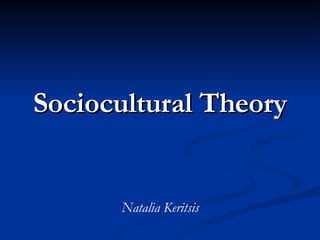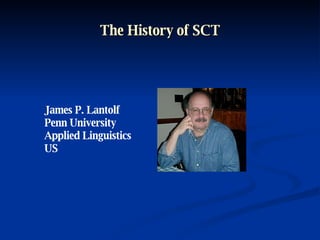Lev Vygotsky And Sociocultural Theory
- 1. Sociocultural Theory Natalia Keritsis
- 2. Lev Vygotsky and Sociocultural Theory ŌĆ£ We can formulate the genetic law of cultural development in the following way: any function in the childŌĆÖs cultural development appears on stage twice, on two planes. First it appears on the social plane, then on the psychological, first among people as an interphysical category and then within the child as an intraphysical category.ŌĆØ
- 3. Four Basic Principles Underlying the Vygotskian Framework Language plays a central role in mental development Consider private speech, where children speak to themselves to plan or guide their own behavior. This is most common among preschoolers, who havenŌĆÖt yet learned proper social skills but rather explore the idea of it. Children often use private speech when the task becomes too difficult and the child doesnŌĆÖt know how to proceed. Private speech helps the child accomplish a task.. Vygotsky believed private speech changes with age, by becoming softer or being just a whisper. 1
- 4. Development can not be separated from its social context This theory suggests that social interaction leads to continuous step-by-step changes in childrenŌĆÖs thought and behavior that can vary greatly from culture to culture. Development depends on interaction with people and the tools that the culture provides to help form their own view of the world. There are three ways a cultural tool can be passed from one Individual to another: imitative learning, instructed learning, and self-regulated learning. 2 Four Basic Principles Underlying the Vygotskian Framework
- 5. Learning can lead development 3 Vygotsky believed that any pedagogy creates learning processes that lead to development and this sequence results in zones of proximal development. It's the concept that a child accomplishes a task that he/she cannot do alone, with the help from a more skilled person. Vygotsky also described the ZPD as the difference between the actual development level as determined by individual problem solving and the level of potential development as determined through problem solving under adult guidance or collaboration with more knowledgeable peers. The result of this process is children become more socialized in the dominant culture and it induces cognitive development. Four Basic Principles Underlying the Vygotskian Framework
- 6. Four Basic Principles Underlying the Vygotskian Framework Children construct their knowledge 4 Human behavior results from the integration of socially and culturally constructed forms of mediation into human activity.
- 7. The Key Terms of SCT SCT Activity Theory ZPD Mediation Internalization Inner Speech Input Output
- 8. Check your understanding Activity Theory ZPD Inner Speech Mediation Internalization A. Humans do not act directly on the physical world but rely on tools, which allow us to change the world. B. Reconstruction of socially mediated external forms on the psychological plane. C. Human behavior results from the integration of socially and culturally constructed forms of mediation into human activity. D. Through this process higher forms of mediation come to be. E. It is not directed at the other person, rather it is oriented to the children themselves . F. What a person can achieve when acting alone is different from what the same person can accomplish with support from someone else. 5 = 6
- 9. The History of SCT Luria 1902-1977 neuropsychologist Russia Lev Vygotsky 1896-1934 Founder of SCT Russia
- 10. The History of SCT Alexey N. Leontiev 1903-1979 Developmental psychologist, Founder of Activity Theory Russia Alexey A. Leontiev Russia, reading a lecture about his father
- 11. The History of SCT James P. Lantolf Penn University Applied Linguistics US
- 12. The End












